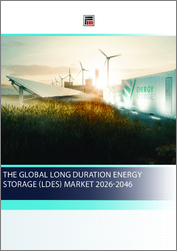
|
시장보고서
상품코드
1865162
장기간 에너지 저장Long-Duration Energy Storage - Emerging LDES Solutions: Global Market Analysis and Forecasts, 2025-2034 |
||||||
장기간 에너지 저장(LDES)은 안전하고 저탄소 에너지 시스템의 중요한 구성 요소로 점점 더 많이 인식되고 있습니다. 화석연료 발전이 간헐적인 재생에너지로 대체되는 가운데, LDES는 장기적인 수급 균형 조정, 계통 안정성 유지, 재생에너지의 추가 통합을 실현하는 데 필요한 유연성을 제공합니다. 단시간 축전 시스템이 주로 시간 단위의 변동에 대응하는 반면, LDES는 수일 또는 계절 단위 수요를 지원하여 화석연료에 의한 피크 대응 발전소 의존도를 낮추고, 장기 정전시 중요 시설에 대한 내결함성을 제공합니다. 이러한 역량으로 LDES는 탈탄소화 및 에너지 안보 목표 달성을 위한 기반 기술로 자리매김하고 있습니다.
이 보고서에서는 향후 10년간 LDES 시스템 세계 시장을 분석하며, 특히 신기술과 그 상용화 준비 상황에 초점을 맞추었습니다. 비양수발전 이외의 대안은 대부분 도입 초기 단계에 있고, 비용, 확장성, 시장 설계와 관련된 고유한 과제에 직면해 있으므로 분석에서는 기술 성숙도 수준(TRL)과 단기적인 보급 형성에 있으며, 정책적 지원의 역할에 중점을 두었습니다. 용량 및 매출 예측은 가이드하우스 조사의 '에너지 저장 시스템 추적기'의 프로젝트 수준 데이터를 기반으로 합니다. 전 세계 누적 LDES 용량(양수발전 제외)은 2034년까지 439.4GWh에 달할 것으로 예측됩니다.
관심 증가에도 불구하고 상업적 실현 가능성은 여전히 제약이 있습니다. 그 요인으로는 높은 초기 비용, 수입원의 불확실성, 장기간의 유연성을 평가할 수 없는 불충분한 시장 구조를 들 수 있습니다. 규제의 복잡성, 인허가 지연, 계통연계 문제가 추가적인 리스크를 가중시키고, 표준화된 성과지표의 부재는 프로젝트 평가를 복잡하게 만들고 있습니다. 많은 기술들이 아직 파일럿 단계에서 상업적 전개로 확장하는 단계에 있으며, 은행 대출이 가능한 비즈니스 모델을 구축하는 것이 어렵습니다. 시장 설계가 가장 중요한 장벽이며, 명확한 경제적 신호와 장기적인 인센티브가 없다면 기술적 필요성이 있음에도 불구하고 투자는 제한적일 것입니다. 따라서 향후 10년간 시장 성장을 위해서는 지속적인 정책적 지원이 필수적입니다.
목차
제1장 개요
제2장 시장의 문제
- 서론
- LDES 기술
- 전기화학
- 열
- 기계
- 촉진요인
- 탈탄소화, 재생에너지 통합, 그리고 전력계통 레질리언스
- 정책 지원, 장려책, 규제 메커니즘
- 시장 수요와 투자
- 장벽
- 비용 경쟁력과 기술 경쟁
- 매출 창출과 시장 구조
- 기술적 성숙도, 확장성, 배포 제약
제3장 산업 밸류체인
- 경쟁 구도와 투자 활동
- 가격결정과 비즈니스 모델
- 기술 준비
제4장 시장 예측
제5장 결론·제안
- 3대 포인트
- 권장사항
- 정책 입안자와 규제기관
- LDES 프로바이더
- 투자자와 금융기관
- 유틸리티 및 송전망 운영자
- 하이퍼스케일러 및 기타 대규모 에너지 사용자
제6장 두자어와 약어 리스트
제7장 목차
제8장 도표
제9장 조사 범위, 정보원, 조사 방법 및 주석
KSA 25.11.20Long-duration energy storage (LDES) is increasingly recognized as a vital component of a secure, low-carbon energy system. As fossil-based generation gives way to intermittent renewable power, LDES provides the flexibility needed to balance supply and demand over extended periods, maintain grid stability, and enable deeper renewable integration. Unlike short-duration systems, which typically address hourly fluctuations, LDES can support multiday or seasonal needs, reduce reliance on fossil peaker plants, and deliver resilience for critical facilities during prolonged outages. These capabilities position LDES as a foundational technology for achieving decarbonization and energy security goals.
This report analyzes the global market for LDES systems over the next decade with a particular focus on emerging technologies and their readiness for commercialization. Because most non-pumped hydro options are still early in deployment and face distinct challenges around cost, scalability, and market design, the analysis emphasizes technology readiness level (TRL) and the role of policy support in shaping near-term adoption. Capacity and revenue forecasts are based on project-level data from Guidehouse Research's Energy Storage Systems Tracker. Global cumulative LDES capacity (excluding pumped hydro) is expected to reach 439.4 GWh by 2034.
Despite growing interest, commercial viability remains constrained by high upfront costs, uncertain revenue streams, and inadequate market structures that fail to value long-duration flexibility. Regulatory complexity, permitting delays, and grid connection challenges add further risk, while the absence of standardized performance metrics complicates project evaluation. Many technologies are still scaling from pilot to commercial deployment, making it difficult to establish bankable business models. Market design remains the most critical barrier: without clear economic signals and long-term incentives, investment will be limited despite technical need. Sustained policy support will therefore be essential to enable market growth over the next decade.
Table of Contents
1. Executive Summary
2. Market Issues
- 2.1 Introduction
- 2.2 LDES Technologies
- 2.2.1 Electrochemical
- 2.2.1.1 Flow Batteries
- 2.2.1.2 Iron-Air Batteries
- 2.2.2 Thermal
- 2.2.3 Mechanical
- 2.2.3.1 Pumped Hydro
- 2.2.3.2 CAES
- 2.2.3.3 LAES
- 2.2.1 Electrochemical
- 2.3 Drivers
- 2.3.1 Decarbonization, Renewable Integration, and Grid Resilience
- 2.3.2 Policy Support, Incentives, and Regulatory Mechanisms
- 2.3.3 Market Demand and Investment
- 2.4 Barriers
- 2.4.1 Cost-Competitiveness and Technology Competition
- 2.4.2 Revenue Generation and Market Structure
- 2.4.3 Technological Maturity, Scalability, and Deployment Constraints
3. Industry Value Chain
- 3.1 Competitive Landscape and Investment Activity
- 3.2 Pricing and Business Models
- 3.3 Technology Readiness
4. Market Forecasts
- 4.1 Methodology
- 4.2 Global Forecasts
- 4.2.1 Capacity
- 4.2.2 Revenue
5. Conclusions and Recommendations
- 5.1 Three Big Takeaways
- 5.2 Recommendations
- 5.2.1 Policymakers and Regulators
- 5.2.2 LDES Providers
- 5.2.3 Investors and Financial Institutions
- 5.2.4 Utilities and Grid Operators
- 5.2.5 Hyperscalers and Other Large Energy Users



















